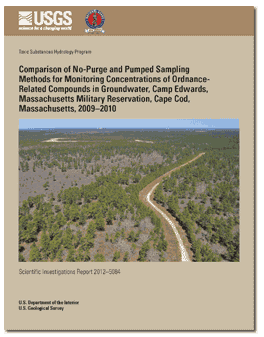Scientific Investigations Report 2012–5084

ABSTRACTField tests were conducted near the Impact Area at Camp Edwards on the Massachusetts Military Reservation, Cape Cod, Massachusetts, to determine the utility of no-purge groundwater sampling for monitoring concentrations of ordnance-related explosive compounds and perchlorate in the sand and gravel aquifer. The no-purge methods included (1) a diffusion sampler constructed of rigid porous polyethylene, (2) a diffusion sampler constructed of regenerated-cellulose membrane, and (3) a tubular grab sampler (bailer) constructed of polyethylene film. In samples from 36 monitoring wells, concentrations of perchlorate (ClO4-), hexahydro-1,3,5-trinitro-1,3,5-triazine (RDX), and octahydro-1,3,5,7-tetranitro-1,3,5,7-tetrazocine (HMX), the major contaminants of concern in the Impact Area, in the no-purge samples were compared to concentrations of these compounds in samples collected by low-flow pumped sampling with dedicated bladder pumps. The monitoring wells are constructed of 2- and 2.5-inch-diameter polyvinyl chloride pipe and have approximately 5- to 10-foot-long slotted screens. The no-purge samplers were left in place for 13–64 days to ensure that ambient groundwater flow had flushed the well screen and concentrations in the screen represented water in the adjacent formation. The sampling methods were compared first in six monitoring wells. Concentrations of ClO4-, RDX, and HMX in water samples collected by the three no-purge sampling methods and low-flow pumped sampling were in close agreement for all six monitoring wells. There is no evidence of a systematic bias in the concentration differences among the methods on the basis of type of sampling device, type of contaminant, or order in which the no-purge samplers were tested. A subsequent examination of vertical variations in concentrations of ClO4- in the 10-foot-long screens of six wells by using rigid porous polyethylene diffusion samplers indicated that concentrations in a given well varied by less than 15 percent and the small variations were unlikely to affect the utility of the various sampling methods. The grab sampler was selected for additional tests in 29 of the 36 monitoring wells used during the study. Concentrations of ClO4-, RDX, HMX, and other minor explosive compounds in water samples collected by using a 1-liter grab sampler and low-flow pumped sampling were in close agreement in field tests in the 29 wells. A statistical analysis based on the sign test indicated that there was no bias in the concentration differences between the methods. There also was no evidence for a systematic bias in concentration differences between the methods related to location of the monitoring wells laterally or vertically in the groundwater-flow system. Field tests in five wells also demonstrated that sample collection by using a 2-liter grab sampler and sequential bailing with the 1-liter grab sampler were options for obtaining sufficient sample volume for replicate and spiked quality assurance and control samples. The evidence from the field tests supports the conclusion that diffusion sampling with the rigid porous polyethylene and regenerated-cellulose membranes and grab sampling with the polyethylene-film samplers provide comparable data on the concentrations of ordnance-related compounds in groundwater at the MMR to that obtained by low-flow pumped sampling. These sampling methods are useful methods for monitoring these compounds at the MMR and in similar hydrogeologic environments. |
First posted September 21, 2012 For additional information contact: Part or all of this report is presented in Portable Document Format (PDF); the latest version of Adobe Reader or similar software is required to view it. Download the latest version of Adobe Reader, free of charge. |
Savoie, J.G., and LeBlanc, D.R., 2012, Comparison of no-purge and pumped sampling methods for monitoring concentrations of ordnance-related compounds in groundwater, Camp Edwards, Massachusetts Military Reservation, Cape Cod, Massachusetts, 2009–2010: U.S. Geological Survey Scientific Investigations Report 2012–5084, 23 p. (Also available at http://pubs.usgs.gov/sir/2012/5084.)
Acknowledgments
Abstract
Introduction
Groundwater at the Massachusetts Military Reservation
Purpose and Scope
Design of Study
Monitoring-Well Selection and Construction
Low-Flow Pumped Sampling Method
No-Purge Sampling Methods
Implementation of Field Tests
Laboratory Analysis
Comparisons of Concentrations
Comparison of Pumped and No-Purge Sampling Methods
Comparison of Diffusion and Grab Sampling to Pumped Sampling
Vertical Variations of Perchlorate Concentrations in Monitoring-Well Screens
Comparison of Pumped and Grab Sampling Methods
Collection of Replicate and Large-Volume Samples
Implications of the Choice of Sampling Methods
Summary
References Cited